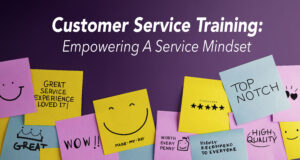Is Your Selling Approach Really Focused on Customer Needs?

As customers, we’ve all been on the receiving end of one or more of the common selling strategies. Here are a few you’ve probably seen:
- A product focus is when salespeople spend most of their time showing and talking about their product or service, its features, advantages and benefits. Objective: Help people understand their product or service so that they’ll want to buy it.
- A transaction focus is used by salespeople whose main goal is to “get people to the yes”—in other words, to agree to buy whatever they’re selling. Objective: Make the sale, whatever it takes.
- A customer-needs focus is when salespeople go through a discovery process to determine if customers have needs, wants, problems or objectives they want filled, satisfied or solved. Objective: Establish a need before initiating any selling activity.
Thinking back to your experiences as a customer, how did you feel in these different scenarios? Were you bored? On the defensive? Did you learn something about your needs or discover a pressing challenge that you hadn’t even realized existed before? Or did you just want to get off the phone or run for the nearest exit as fast as you could?
With both product- and transaction-focused selling approaches, the salesperson is essentially trying to convince you that this product or this “deal” is so great that you simply must have it. Their success comes down to how effective they are at persuading you to believe their position.
In fact, many salespeople will say they take a customer-needs-focused approach, but their actions say otherwise. You can tell because they’re still falling back on this idea that they need to sway you or influence you to do something (the implication being that it’s something you don’t really want to do). No wonder customers often feel like they need to push back in these situations. It’s basically a battle of wills, one that’s being fought on a simmering ground of doubt and distrust.
With a true customer-needs selling approach, on the other hand, the salesperson is focused on helping you get a clearer picture of your own situation so that, together, you can identify what the requirements are and how they can best be satisfied. Their success comes down to how effective they are at bringing your true needs to the surface and the overall value they deliver in filling those needs.
Instead of trying to convince you to buy something, these salespeople spend most of their time finding out if you have needs that they can address. No solutions are even offered until your wants or needs have been admitted.
Here’s the kicker: Our research shows that when people sell this way, they can experience a 15 to 30 percent increase in their sales.
To understand why, we have to look at what we know about the art of persuasion: The more we attempt to persuade people, the more they tend to resist us. But the more we attempt to understand them and create value for them, the more they tend to persuade themselves.
What is your focus?
If you’re in sales, one easy way to identify your own central sales focus is to think about how you spend your time when talking to customers.
Do you spend most of your time in the first half of your contact talking about your product or service? Or do you spend most of your time asking questions that focus on the customer’s needs?
In the interview stage of an effective customer-needs-focused selling process, you should be spending at least 80% of the time listening. And when you do talk, it should be mostly in the form of questions and paraphrasing back to customers what they tell you to make sure you understand them. You explore, ask questions and get feedback, and you make no attempt to sell anything until the customer:
- admits needs, wants, problems or objectives they want filled, satisfied or solved.
- agrees that not only do they have needs but that they are open to solutions.
- agrees to talk to you about a solution.
- confirms that they can make purchase decisions.
Generally, if they don’t agree to all four of these steps, you probably don’t have a good prospect. Or they aren’t the real decision makers. Or they don’t have a compelling reason to take action. Or they aren’t favorably disposed to buying from you.
Take a closer look at your own selling approach to make sure you’re truly focused on creating value for your customers rather than wearing them down to buy from you. One of the most important questions you can start with is this:
In your typical selling situations, who does most of the talking?
If it’s you, chances are, your focus is more product-oriented or transactional, and it’s likely keeping you from reaching your full sales potential.

Chief Marketing Officer
Related Blog Posts



